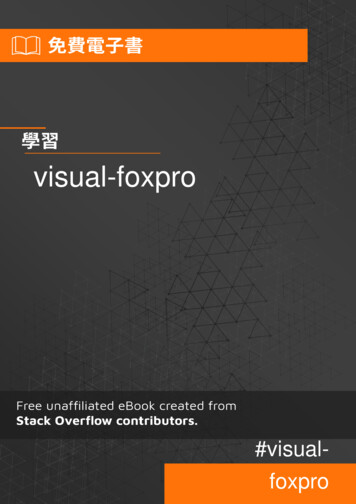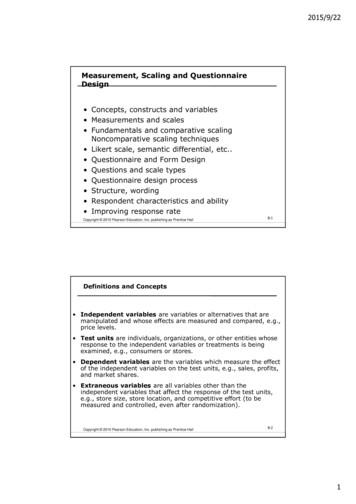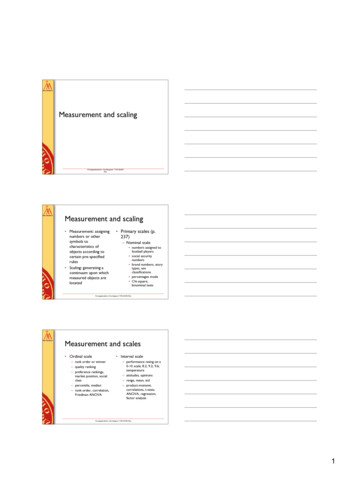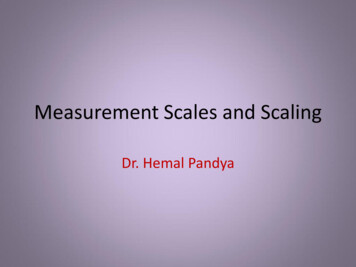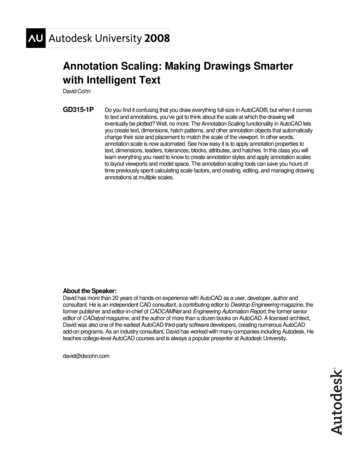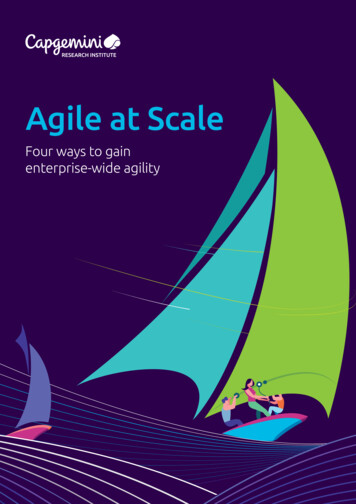
Transcription
Scaling Up Visual and Vision-Language Representation LearningWith Noisy Text SupervisionChao Jia 1 Yinfei Yang 1 Ye Xia 1 Yi-Ting Chen 1 Zarana Parekh 1 Hieu Pham 1 Quoc V. Le 1Yunhsuan Sung 1 Zhen Li 1 Tom Duerig 1AbstractPre-trained representations are becoming crucialfor many NLP and perception tasks. While representation learning in NLP has transitioned to training on raw text without human annotations, visual and vision-language representations still relyheavily on curated training datasets that are expensive or require expert knowledge. For vision applications, representations are mostly learned usingdatasets with explicit class labels such as ImageNet or OpenImages. For vision-language, popular datasets like Conceptual Captions, MSCOCO,or CLIP all involve a non-trivial data collection(and cleaning) process. This costly curation process limits the size of datasets and hence hindersthe scaling of trained models. In this paper, weleverage a noisy dataset of over one billion imagealt-text pairs, obtained without expensive filtering or post-processing steps in the ConceptualCaptions dataset. A simple dual-encoder architecture learns to align visual and language representations of the image and text pairs using acontrastive loss. We show that the scale of ourcorpus can make up for its noise and leads tostate-of-the-art representations even with such asimple learning scheme. Our visual representationachieves strong performance when transferred toclassification tasks such as ImageNet and VTAB.The aligned visual and language representationsenables zero-shot image classification and alsoset new state-of-the-art results on Flickr30K andMSCOCO image-text retrieval benchmarks, evenwhen compared with more sophisticated crossattention models. The representations also enablecross-modality search with complex text and text image queries.1. IntroductionIn the existing literature, visual and vision-language representation learning are mostly studied separately with different training data sources. In the vision domain, pre-trainingon large-scale supervised data such as ImageNet (Denget al., 2009), OpenImages (Kuznetsova et al., 2020), and JFT300M (Sun et al., 2017; Kolesnikov et al., 2020) has provento be critical for improving performance on downstreamtasks via transfer learning. Curation of such pre-trainingdatasets requires heavy work on data gathering, sampling,and human annotation, and hence is difficult to scale.Pre-training has also become the de-facto approachin vision-language modeling (Lu et al., 2019; Chenet al., 2020c; Li et al., 2020). However, vision-languagepre-training datasets such as Conceptual Captions (Sharmaet al., 2018), Visual Genome Dense Captions (Krishnaet al., 2016), and ImageBERT (Qi et al., 2020) requireeven heavier work on human annotation, semantic parsing,cleaning and balancing. As a result, the scales of thesedatasets are only in the realm of 10M examples. This is atleast an order of magnitude smaller than their counterpartsin the vision domain, and much smaller than large corporaof text from the internet for NLP pre-training (e.g., Devlinet al. (2019); Radford et al. (2019); Yang et al. (2019); Liuet al. (2019b); Raffel et al. (2020)).In this work, we leverage a dataset of over one billion noisyimage alt-text pairs to scale visual and vision-language representation learning. We follow the procedures describedin the Conceptual Captions dataset (Sharma et al., 2018)to have a large noisy dataset. But instead of applying thecomplex filtering and post-processing steps as proposedby (Sharma et al., 2018) to clean the dataset, we only applysimple frequency-based filtering. The resulting dataset isnoisy, but is two orders of magnitude larger than the Conceptual Captions dataset. We show that visual and visionlanguage representations pre-trained on our exascale datasetachieve very strong performance on a wide range of tasks.1Google Research. Correspondence to: Chao Jia chaojia@google.com , Yinfei Yang yinfeiy@google.com .Proceedings of the 38 th International Conference on MachineLearning, PMLR 139, 2021. Copyright 2021 by the author(s).To train our model, we use an objective that aligns the visualand language representations in a shared latent embeddingspace using a simple dual-encoder architecture. Similar
Scaling Up Visual and Vision-Language Representation Learning With Noisy Text SupervisionPre-training(Zero-shot) Visual TasksContrastive LearningTextEncoderImageEncoderNoisy Image-TextDataImageNet (Deng et al. 2009)figure credit to (Krizhevsky et al. 2012)Fine-grained Image-Text Retrieval“Roppongi Hills Spider at night”Flickr30k (Plummer et al. 2015), MSCOCO(Chen et al. 2015), .“original picture ofmonet haystack”“monet haystack png”(A) Text - Image RetrievalVisual Task Adaptation Benchmark (VTAB)(Zhai et al. 2019)“snow”“haystack seriesmonet art institute ofchicago”.(B) Image - Text Retrieval(C) Image Text - Image RetrievalFigure 1. A summary of our method, ALIGN. Visual and language representations are jointly learned from noisy image alt-text data. Therepresentations can be used for vision-only or vision-language task transfer. Without any fine-tuning, ALIGN powers zero-shot visualclassification and cross-modal search including image-to-text search, text-to-image search and even search with joint image text queries.objectives has been applied to learning visual-semanticembeddings (VSE) (Frome et al., 2013; Faghri et al., 2018).We name our model ALIGN: A Large-scale ImaGe andNoisy-text embedding. Image and text encoders are learnedvia a contrastive loss (formulated as normalized softmax)that pushes the embeddings of matched image-text pairtogether while pushing those of non-matched image-textpair apart. This is one of the most effective loss functionsfor both self-supervised (Chen et al., 2020b) and supervised(Zhai & Wu, 2019; Musgrave et al., 2020) representationlearning. Considering paired texts as fine-grained labels ofimages, our image-to-text contrastive loss is analogous tothe conventional label-based classification objective; andthe key difference is that the text encoder generates the“label” weights. The top-left of Figure 1 summarizes themethod we use in ALIGN.The aligned image and text representations are naturallysuited for cross-modality matching/retrieval tasks andachieve state-of-the-art (SOTA) results in correspondingbenchmarks. For instance, ALIGN outperforms the previousSOTA method by over 7% in most zero-shot and fine-tunedR@1 metrics in Flickr30K and MSCOCO. Moreover, suchcross-modality matching naturally enables zero-shot imageclassification when feeding the classnames into the text encoder, achieving 76.4% top-1 accuracy in ImageNet withoutusing any of its training samples. The image representation itself also achieves superior performance in variousdownstream visual tasks. For example, ALIGN achieves88.64% top-1 accuracy in ImageNet. Figure 1-bottom showsthe cross-modal retrieval examples that come from a realretrieval system built by ALIGN.2. Related WorkHigh-quality visual representations for classification orretrieval are usually pre-trained on large-scale labeleddatasets (Mahajan et al., 2018; Kolesnikov et al., 2020;Dosovitskiy et al., 2021; Juan et al., 2020). Recently,self-supervised (Chen et al., 2020b; Tian et al., 2020;He et al., 2020; Misra & Maaten, 2020; Li et al., 2021;Grill et al., 2020; Caron et al., 2020) and semi-supervisedlearning (Yalniz et al., 2019; Xie et al., 2020; Pham et al.,2020) have been studied as alternative paradigms. However,models trained by these methods so far show limitedtransferability to downstream tasks (Zoph et al., 2020).Leveraging images and natural language captions is anotherdirection of learning visual representations. Joulin et al.(2015); Li et al. (2017); Desai & Johnson (2020); Sariyildizet al. (2020); Zhang et al. (2020) show that a good visualrepresentation can be learned by predicting the captionsfrom images, which inspires our work. These works arehowever limited to small datasets such as Flickr (Joulinet al., 2015; Li et al., 2017) and COCO Captions (Desai& Johnson, 2020; Sariyildiz et al., 2020), and the resultingmodels don’t produce a vision-language representation thatis needed for tasks like cross-modal retrieval.In the vision-language representation learning domain,visual-semantic embeddings (VSE) (Frome et al., 2013;Faghri et al., 2018) and improved versions (e.g., leveragingobject detectors, dense feature maps, or multi-attentionlayers) (Socher et al., 2014; Karpathy et al., 2014; Kiroset al.; Nam et al., 2017; Li et al., 2019; Messina et al., 2020;Chen et al., 2020a) have been proposed. Recently more
Scaling Up Visual and Vision-Language Representation Learning With Noisy Text Supervisionadvanced models emerge with cross-modal attention layers(Liu et al., 2019a; Lu et al., 2019; Chen et al., 2020c; Huanget al., 2020b) and show superior performance in image-textmatching tasks. However, they are orders of magnitudesslower and hence impractical for image-text retrievalsystems in the real world. In contrast, our model inheritsthe simplest VSE form, but still outperforms all previouscross-attention models in image-text matching benchmarks.Closely related to our work is CLIP (Radford et al., 2021),which proposes visual representation learning via naturallanguage supervision in a similar contrastive learningsetting. Besides using different vision and language encoderarchitectures, the key difference is on training data: ALIGNfollows the natural distribution of image-text pairs from theraw alt-text data, while CLIP collects the dataset by firstconstructing an allowlist of high-frequency visual conceptsfrom English Wikipedia. We demonstrate that strong visualand vision-language representations can be learned witha dataset that doesn’t require expert knowledge to curate.3. A Large-Scale Noisy Image-Text DatasetThe focus of our work is to scale up visual and visionlanguage representation learning. For this purpose, we resortto a much larger dataset than existing ones. Specifically,we follow the methodology of constructing ConceptualCaptions dataset (Sharma et al., 2018) to get a version ofraw English alt-text data (image and alt-text pairs). TheConceptual Captions dataset was cleaned by heavy filteringand post-processing. Here, for the purpose of scaling, wetrade quality for scale by relaxing most of the cleaningsteps in the original work. Instead, we only apply minimalfrequency-based filtering as detailed below. The result is amuch larger (1.8B image-text pairs) but noisier dataset. Figure 2 shows some sample image-text pairs from the dataset.“motorcycle front wheel”“thumbnail for version as of 2157 29 june 2010”“file frankfurt airportskyline 2017 05 jpg”ratio is smaller than 3. Images with more than 1000 associated alt-texts are discarded. To ensure that we don’t train ontest images, we also remove duplicates or near-duplicatesof test images in all downstream evaluation datasets (e.g.,ILSVRC-2012, Flickr30K, and MSCOCO). See supplementary material for more details.Text-based filtering. We exclude alt-texts that are sharedby more than 10 images. These alt-texts are often irrelevantto the content of the images (e.g., “1920x1080”, “alt img”,and “cristina”). We also discard alt-texts that contain anyrare token (outside of 100 million most frequent unigramsand bigrams from the raw dataset), and those that are either too short ( 3 unigrams) or too long ( 20 unigrams).This removes noisy texts like “image tid 25&id mggqpuweqdpd&cache 0&lan code 0”, or texts that are too generic tobe useful.4. Pre-training and Task Transfer4.1. Pre-training on Noisy Image-Text PairsWe pre-train ALIGN using a dual-encoder architecture. Themodel consists of a pair of image and text encoders with acosine-similarity combination function at the top. We useEfficientNet with global pooling (without training the 1x1conv layer in the classification head) as the image encoderand BERT with [CLS] token embedding as the text embedding encoder (we generate 100k wordpiece vocabularyfrom our training dataset). A fully-connected layer withlinear activation is added on top of BERT encoder to matchthe dimension from the image tower. Both image and textencoders are trained from scratch.The image and text encoders are optimized via normalizedsoftmax loss (Zhai & Wu, 2019). In training, we treatmatched image-text pairs as positive and all other randomimage-text pairs that can be formed in a training batch asnegative.We minimize the sum of two losses: one for image-to-textclassificationNexp(x 1 Xi yi /σ)Li2t log PN(1) Nij 1exp(xi yj /σ)and the other for text-to-image classification“file london barge race 2 jpg”“moustache seamlesswallpaper design”“st oswalds way and shops”Figure 2. Example image-text pairs randomly sampled from thetraining dataset of ALIGN. One clearly noisy text annotation ismarked in italics.Image-based filtering. Following Sharma et al. (2018),we remove pornographic images and keep only imageswhose shorter dimension is larger than 200 pixels and aspectLt2i Nexp(yi xi /σ)1 Xlog PNNexp(yi xj /σ)i(2)j 1Here, xi and yj are the normalized embedding of image inthe i-th pair and that of text in the j-th pair, respectively. Nis the batch size, and σ is the temperature to scale the logits.For in-batch negatives to be more effective, we concatenateembeddings from all computing cores to form a much largerbatch. The temperature variable is crucial as both image
Scaling Up Visual and Vision-Language Representation Learning With Noisy Text Supervisionand text embeddings are L2-normalized. Instead of manually sweeping for the optimal temperature value, we findthat it can be effectively learned together with all the otherparameters.4.2. Transferring to Image-Text Matching & RetrievalWe evaluate ALIGN models on image-to-text and text-toimage retrieval tasks, with and without finetuning. Twobenchmark datasets are considered: Flickr30K (Plummeret al., 2015) and MSCOCO (Chen et al., 2015). We alsoevaluate ALIGN on Crisscrossed Captions (CxC) (Parekhet al., 2021), which is an extension of MSCOCO withadditional human semantic similarity judgments forcaption-caption, image-image, and image-caption pairs.With extended annotations, CxC enables four intra- andinter-modal retrieval tasks including image-to-text, text-toimage, text-to-text, and image-to-image retrieval, and threesemantic similarity tasks including semantic textual similarity (STS), semantic image similarity (SIS), and semanticimage-text similarity (SITS). As the training set is identicalto the original MSCOCO, we can directly evaluate theMSCOCO fine-tuned ALIGN model on CxC annotations.4.3. Transferring to Visual ClassificationWe first apply zero-shot transfer of ALIGN to visual classification tasks on ImageNet ILSVRC-2012 benchmark (Denget al., 2009) and its variants including ImageNet-R(endition)(Hendrycks et al., 2020) (non-natural images such as art,cartoons, sketches), ImageNet-A(dversarial) (Hendryckset al., 2021) (more challenging images for ML models), andImageNet-V2 (Recht et al., 2019). All of these variantsfollow the same set (or a subset) of ImageNet classes, whilethe images in ImageNet-R and ImageNet-A are sampledfrom drastically different distributions from ImageNet.We also transfer the image encoder to downstream visualclassification tasks. For this purpose, we use the ImageNetas well as a handful of smaller fine-grained classification datasets such as Oxford Flowers-102 (Nilsback &Zisserman, 2008), Oxford-IIIT Pets (Parkhi et al., 2012),Stanford Cars (Krause et al., 2013), and Food101 (Bossardet al., 2014). For ImageNet, results from two settings arereported: training the top classification layer only (withfrozen ALIGN image encoder) and fully fine-tuned. Onlythe latter setting is reported for fine-grained classificationbenchmarks. Following Kolesnikov et al. (2020), wealso evaluate the robustness of our model on Visual TaskAdaptation Benchmark (VTAB) (Zhai et al., 2019) whichconsists of 19 diverse (covering subgroups of natural,specialized and structured image classification tasks) visualclassification tasks with 1000 training samples each.5. Experiments and ResultsWe train our ALIGN models from scratch, using the opensourced implementation of EfficientNet as the image encoder and BERT as the text encoder. Unless in the ablationstudy, we use the results of ALIGN where the image encoderis EfficientNet-L2 and the text encoder is BERT-Large. Theimage encoder is trained at resolution of 289 289 pixelsno matter what EfficientNet variant is used. We first resizeinput images to 346 346 resolution and then perform random crop (with additional random horizontal flip) in trainingand central crop in evaluation. For BERT we use wordpiecesequence of maximum 64 tokens since the input texts areno longer than 20 unigrams. The softmax temperature variable is initialized as 1.0 (this temperature variable is sharedbetween image-to-text loss and text-to-image loss) and weuse 0.1 as label smoothing parameter in the softmax losses.We use LAMB optimizer (You et al., 2020)1 with weightdecay ratio 1e-5. The learning rate is warmed up linearlyto 1e-3 from zero in 10k steps, and then linearly decay tozero in 1.2M steps ( 12 epochs). We train the model on1024 Cloud TPUv3 cores with 16 positive pairs on eachcore. Therefore the total effective batch size is 16384.5.1. Image-Text Matching & RetrievalWe evaluate ALIGN on Flickr30K and MSCOCO crossmodal retrieval benchmarks, in both zero-shot and fullyfine-tuned settings. We follow (Karpathy & Fei-Fei, 2015)and most existing works to obtain the train/test splits. Specifically, for Flickr30K, we evaluate on the standard 1K testset, and finetune on the 30k training set. For MSCOCO, weevaluate on the 5K test set, and finetune on 82K trainingplus 30K additional validation images that are not in the 5Kvalidation or 5K test sets.During fine-tuning, the same loss function is used. But therecan be false negatives when the batch size is comparableto the total number of training samples. So we reduce theglobal batch size from 16384 to 2048. We also reduce the initial learning rate to 1e-5 and train for 3K and 6K steps (withlinear decay) respectively on Flickr30K and MSCOCO. Allthe other hyper-parameters are kept the same as pre-training.Table 1 shows that, compared to previous works, ALIGNachieves SOTA results in all metrics of Flickr30K andMSCOCO benchmarks. In the zero-shot setting, ALIGNgets more than 7% improvement in image retrieval taskcompared to the previous SOTA, CLIP (Radford et al.,2021). With fine-tuning, ALIGN outperforms all existingmethods by a large margin, including those that employmore complex cross-modal attention layers such asImageBERT (Qi et al., 2020), UNITER (Chen et al., 2020c),1We tried SGD with momentum and ADAM which are knownto work well for CNNs and BERT respectively. LAMB appears tobe a better choice for training both image and text encoders.
Scaling Up Visual and Vision-Language Representation Learning With Noisy Text SupervisionTable 1. Image-text retrieval results on Flickr30K and MSCOCO datasets (zero-shot and fine-tuned). ALIGN is compared with ImageBERT (Qi et al., 2020), UNITER (Chen et al., 2020c), CLIP (Radford et al., 2021), GPO (Chen et al., 2020a), ERNIE-ViL (Yu et al.,2020), VILLA (Gan et al., 2020), and Oscar (Li et al., 2020).Flickr30K (1K test set)image texttext 90.693.894.594.193.694.297.4MSCOCO (5K test set)image texttext 070.272.278.688.089.889.8Table 2. Multimodal retrieval performance on Crisscrossed Captions (CxC) dataset. ALIGN is compared with VSE (Faghri et al.,2018), VSRN (Li et al., 2019), DEI2T (Parekh et al., 2021), and DET2T I2T (Parekh et al., 2021).image textVSE VSRNDEI2TDET2T 94.3R@1084.290.091.291.897.4text 9Table 3. Spearman’s R Bootstrap Correlation ( 100) on Crisscrossed Captions (CxC) dataset. ALIGN is compared withVSE (Faghri et al., 2018), VSRN (Li et al., 2019), DEI2T (Parekhet al., 2021), and DET2T I2T (Parekh et al., 2021).ModelVSE VSRNDEI2TDET2T I2TALIGNSTSavg std74.4 0.473.0 0.450.9 0.674.2 0.472.9 0.4SISavg std73.3 0.970.1 1.081.3 0.774.5 0.977.2 0.8SITSavg std55.2 1.560.4 1.361.6 1.461.9 1.367.6 1.2text 4R@562.364.847.164.966.8image EI2T . We suspect it is because the training objective ofALIGN focuses on cross-modal (image-text) matching instead of intra-modal matching. Parekh et al. (2021) suggestmultitask learning could produce more balanced representations. We leave it to the future work.Mean Avg5.2. Zero-shot Visual Classification67.667.864.670.272.6ERNIE-ViL (Yu et al., 2020), VILLA (Gan et al., 2020) andOscar (Li et al., 2020).Table 2 reports the performance of ALIGN on CrisscrossedCaptions (CxC) retrieval tasks. Again, ALIGN achievesSOTA results in all metrics, especially by a large marginon image-to-text ( 22.2% R@1) and text-to-image (20.1%R@1) tasks. Table 3 shows that ALIGN also outperformsthe previous SOTA on SITS task with an improvement of5.7%. One interesting observation is that, despite beingmuch better on inter-modal tasks, ALIGN is not as impressive on intra-modal tasks. For instance, the improvementson text-to-text and image-to-image retrieval tasks (in particular the former) are less significant compared to those onimage-to-text and text-to-image tasks. The performance onSTS and SIS tasks is also slightly worse than VSE andIf we directly feed the texts of classnames into the textencoder, ALIGN is able to classify images into candidateclasses via image-text retrieval. Table 4 compares ALIGNwith CLIP on Imagenet and its variants. Similar to CLIP,ALIGN shows great robustness on classification taskswith different image distributions. In order to make afair comparison, we use the same prompt ensemblingmethod as CLIP. Each classname is expanded with a setof prompt templates defined by CLIP such as “A photoof a {classname}”. The class embedding is computed byaveraging the embeddings of all templates followed by anL2-normalization. We find that such ensembling gives 2.9%improvement on ImageNet top-1 accuracy.Table 4. Top-1 Accuracy of zero-shot transfer of ALIGN to imageclassification on ImageNet and its -V2CLIPALIGN76.276.488.992.277.275.870.170.1
Scaling Up Visual and Vision-Language Representation Learning With Noisy Text SupervisionTable 5. ImageNet classification results. ALIGN is compared with WSL (Mahajan et al., 2018), CLIP (Radford et al., 2021),BiT (Kolesnikov et al., 2020), ViT (Dosovitskiy et al., 2021), NoisyStudent (Xie et al., 2020), and Meta-Pseudo-Labels (Pham et al.,2020).Model (backbone)Acc@1 w/ frozen features Acc@1 Acc@5WSL (ResNeXt-101 32x48d)CLIP (ViT-L/14)BiT (ResNet152 x 4)NoisyStudent (EfficientNet-L2)ViT (ViT-H/14)Meta-Pseudo-Labels (EfficientNet-L2)ALIGN (EfficientNet-L2)83.685.485.55.3. Visual Classification w/ Image Encoder OnlyOn the ImageNet benchmark, we first freeze the learnedvisual features and only train the classification head.Afterwards we fine-tune all layers. We use basic data augmentations including random cropping (same as in Szegedyet al. (2015)) and horizontal flip. In evaluation we apply asingle central crop with ratio of 0.875. Following Touvronet al. (2019), we use 0.8 scale ratio between training andevaluation to mitigate the resolution discrepancy introducedby random crop. Specifically, train/eval resolution is289/360 with frozen visual features, and is 475/600 whenfine-tuning all variables.In both stages of training, we use a global batch size of1024, SGD optimizer with momentum 0.9, and learningrate decayed every 30 epochs with ratio 0.2 (100 epochsin total). Weight decay is set to zero. With frozen visualfeatures, we use the initial learning rate of 0.1. Whenfine-tuning all layers with use the initial learning rate of0.01, and use 10x smaller learning rate on the backbonenetwork compared to the classification head.Table 5 compares ALIGN with previous methods on the ImageNet benchmark. With frozen features, ALIGN slightlyoutperforms CLIP and achieves SOTA result of 85.5% top-1accuracy. After fine-tuning ALIGN achieves higher accuracy than BiT and ViT models, and is only worse than MetaPseudo Labels which requires deeper interaction betweenImageNet training and large-scale unlabeled data. Compared to NoisyStudent and Meta-Pseudeo-Labels which alsouse EfficientNet-L2, ALIGN saves 44% FLOPS by usingsmaller test resolution (600 instead of 800).In VTAB eval, we follow a hyper-parameter sweep as shownin the Appendix I in (Zhai et al., 2019) with 50 trials for eachtask. Each task is trained on 800 images and the hyperparameters are selected using the validation set of 200 images.After the sweep, the selected hyperparameters are used totrain on the combined training and validation splits of 1000images for each task. Table 6 reports the mean accuracy(including the breakdown results on each subgroup) withstandard deviation from three fine-tuning runs and showsthat ALIGN outperforms BiT-L (Kolesnikov et al., 2020)with similar hyper-parameter selection method .898.67Table 6. VTAB (19 tasks) comparison between ALIGN and BiT-L.ModelAll .99 0.1583.3887.5673.25To evaluate on smaller fine-grained classification benchmarks, we adopt a simple fine-tuning strategy for all tasks.We use the same data augmentation and optimizer as in ImageNet fine-tuning. Similarly, we first train the classificationhead and then fine-tune all layers, except with batch normstatistics frozen. The train/eval resolution is fixed at 289/360.We use batch size 256 and weight decay 1e-5. The initiallearning rate is set to 1e-2 and 1e-3 respectively, with cosinelearning rate decay in 20k steps. Table 7 compares ALIGNwith BiT-L (Kolesnikov et al., 2020) and SAM (Foret et al.,2021) which both apply same fine-tuning hyper-parametersfor all tasks.2 For small tasks like these, details in finetuning matter. So we list the baseline results in (Foret et al.,2021) without using SAM optimization for a fairer comparison. Our result (average of three runs) is comparable to theSOTA results without tweaking on optimization algorithms.Table 7. Transfer learning results on Fine-grained Classification Tasks. BiT-L (Kolesnikov et al., 2020) was trained withResNet152 x 4 whereas SAM-baseline, SAM-final (Foret et al.,2021) and ALIGN were trained with 6.0396.1895.886. Ablation StudyIn the ablation study, we compare model performancemostly on MSCOCO zero-shot retrieval and ImageNet KNearest-neighbor (KNN) tasks.3 We find these two met2ViT (Dosovitskiy et al., 2021) uses different hyper-parametersfor different tasks and hence is not included in comparison.3For each image in the validation set of ImageNet, we retrieveits nearest neighbors from the training set w/ pre-trained imageencoder. Recall@K metric is calculated based on if the groundtruthlabel of the query image appears in the top-K retrieved images.
Scaling Up Visual and Vision-Language Representation Learning With Noisy Text Supervisionrics are representative and correlate well with other metricsreported in the section above. If not mentioned, hyperparameters other than the ablated factor are kept the sameas in the baseline model.6.1. Model ArchitecturesWe first study the performance of ALIGN models usingdifferent image and text backbones. We train EfficientNetfrom B1 to L2 for the image encoder and BERT-Mini toBERT-Large for the text encoder. We add an additionalfully-connected layer with linear activation on top of B1,B3, B5 and L2 globally-pooled features to match the outputdimension of B7 (640). A similar linear layer is added toall text encoders. We reduce the training steps to 1M inablation to save some runtime.Figures 3 shows MSCOCO zero-shot retrieval and ImageNet KNN results with different combinations of imageand text backbones. Model quality improves nicely withlarger backbones except that the ImageNet KNN metricstarts to saturate from BERT-Base to BERT-Large withEfficientNet-B7 and EfficientNet-L2. As expected, scalingup image encoder capacity is more important for visiontasks (e.g., even with BERT-Mini text tower, L2 performsbetter than B7 with BERT-Large). In image-text retrievaltasks the image and text encoder capacities are equallyimportant. Based on the nice scaling property shown inFigure 3, we only fine-tune the model with EfficientNet-L2 BERT-Large as reported in Section 5.We then study key architecture hyperparameters includingembedding dimensions, number of random negatives in thebatch, and the softmax temperature. Table 8 compares anumber of model variants to a baseline model (first row)trained with the following settings: EfficientNet-B5 imageencoder, BERT-Base text encoder, embedding dimension640, all negatives in the batch, and a learnable softmaxtemperature.Rows 2-4 of Table 8 show that model performance improveswith higher embedding dimensions. Hence, we let thedimension scale with larger EfficientNet backbone (L2 uses1376). Rows 5 and 6 show that using fewer in-batch neg
by (Sharma et al.,2018) to clean the dataset, we only apply simple frequency-based filtering. The resulting dataset is noisy, but is two orders of magnitude larger than the Con-ceptual Captions dataset. We show that visual and vision-language representations pre-trained on our exascale dataset achieve very strong performance on a wide range of .
